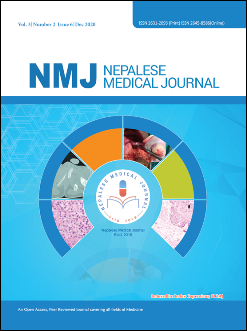Comparative Study of Colorectal Cancer Based on Tumor Location in Adolescent and Young Adult Population in Nepal
DOI:
https://doi.org/10.3126/nmj.v3i2.33087Keywords:
Adolescent; Colorectal cancer; Tumor location; Young adultAbstract
Introduction: Colorectal cancer in the Adolescent and Young Adult population are increasing and are characterized by a more advanced stage at diagnosis, poorer cell differentiation, higher signet ring histology, and left-sided colon location of the primary tumor. This study aims to compare colorectal cancer data in the Adolescent and Young Adult population-based on tumor location.
Materials and Methods: This is a retrospective cross-sectional study of colorectal cancer in the Adolescent and Young Adult population from April 2017 to September 2020 in Shree Birendra Hospital. Data were collected for age, sex, clinical features, histology, TNM stage, colonoscopy finding, radiologic features, treatment, and follow-up status based on tumor location. Data were analyzed using Excel 2010 and SPSS v 17.
Results: The total number of patients was 61 with the mean age of 32.36 ± 6.24 years. There was a male preponderance of 63.93%. Right-sided colorectal cancer was 24.59% while left-sided colorectal cancer was 75.41%. For right-sided colorectal cancers, the most common symptoms were pain abdomen (73.3%) and diarrhea (53.3%) while for left-sided colorectal cancers, it was pain abdomen (80.4%) and bleeding per rectum (45.7%). The most common histology was adenocarcinoma (95.08%) with moderately differentiated being most common in both locations. Surgery, radiation and chemotherapy for right-sided and left-sided colorectal cancer were 86.66%, 0.0%, 86.66% and 58.67%, 28.26%, 89.13% respectively.
Conclusions: Left-sided colorectal cancer was more common in the Adolescent and Young Adult population in our study. There were signifi cant differences in the clinical presentation of colorectal cancer as per the tumor location.
Downloads
Downloads
Published
How to Cite
Issue
Section
License
This license enables reusers to distribute, remix, adapt, and build upon the material in any medium or format, so long as attribution is given to the creator. The license allows for commercial use.
Copyright on any article published by Nepalese Medical Journal is retained by the author(s).
Authors grant Nepalese Medical Journal a license to publish the article and identify itself as the original publisher.
Authors also grant any third party the right to use the article freely as long as its integrity is maintained and its original authors, citation details and publisher are identified.




